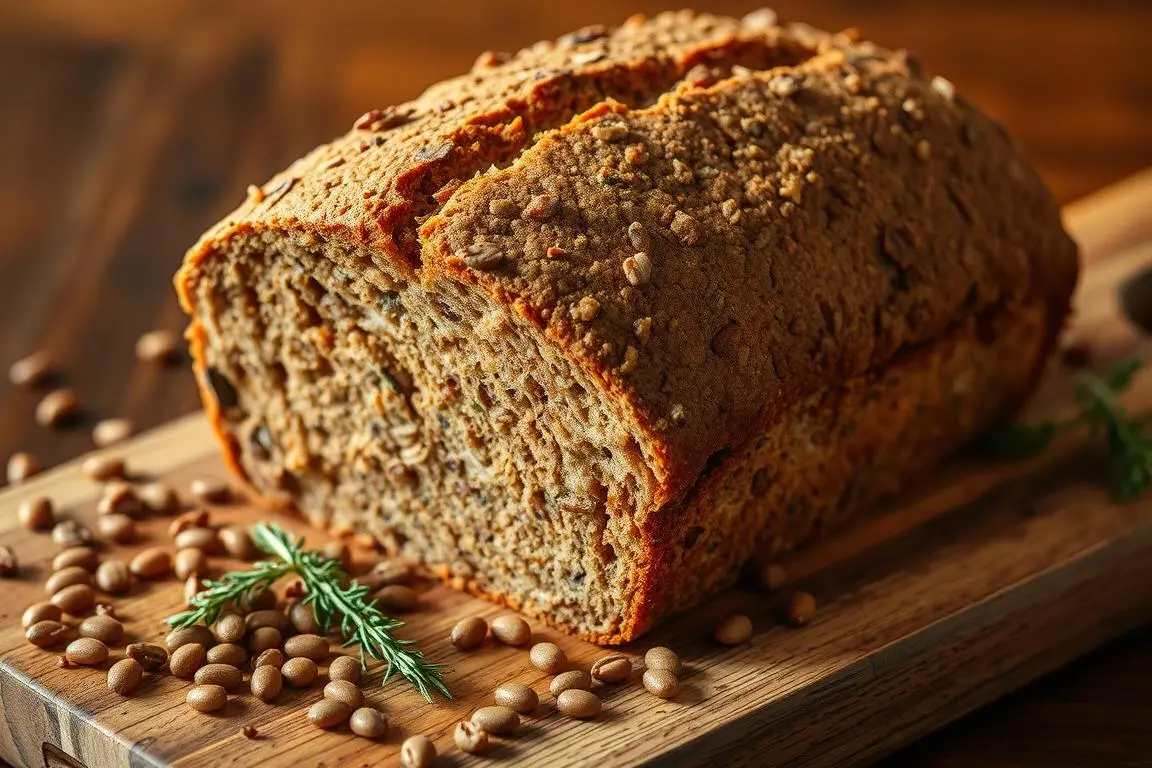In recent years, more people are looking for healthier food options. They are turning to alternative flours like lentils. The question is, is lentil bread really better for you than regular wheat bread? This article looks into lentil bread’s nutritional benefits and how they compare to regular bread.
Key Takeaways
- Lentil bread is gaining traction as a healthy alternative to regular wheat bread.
- Lentils are a rich source of protein, fiber, and essential micronutrients.
- Lentil bread may have a lower glycemic index, potentially benefiting individuals with diabetes or those seeking better blood sugar management.
- Incorporating lentil bread into a balanced diet can provide a nutritious boost to your meals.
- Further research is needed to fully understand the long-term health implications of substituting lentil bread for regular bread.
Understanding the Rise of Lentil Bread as a Healthy Alternative
A big change is happening in bread-making. More people are choosing alternative flour breads. Lentil bread is leading this trend, offering a nutritious twist on a classic food. So, what’s behind the surge in lentil bread popularity?
The Growing Popularity of Alternative Flour Breads
More people want healthier bread options. They’re looking for breads with alternative flour breads, like lentil bread. These options are packed with nutrients and protein, unlike traditional wheat bread.
Why Lentils Are Being Used in Bread Making
Lentils are becoming a favorite in bread-making. They’re a plant-based protein that’s full of fiber, complex carbs, and vitamins. This makes them a top choice for those looking for lentils nutrition in their bread.
Lentils also have special qualities. They help the dough stick together and add moisture. This makes them a great addition to alternative flour breads.

“The rise of lentil bread shows people want nutritious and sustainable food. As they pay more attention to what they eat, lentil bread’s appeal keeps growing.”
Lentil Bread’s Unique Nutritional Benefits
Lentil bread is a healthier choice than regular bread. It’s packed with protein and has a balanced amino acid mix.
Protein Content and Essential Amino Acids
Lentils are a top-notch protein source. They have all the amino acids our bodies need. A slice of lentil bread can have up to 8 grams of protein. That’s way more than the 3-4 grams in regular wheat bread.
Fiber and Micronutrient Analysis
Lentil bread has more fiber than regular bread. This fiber is good for your digestion, blood sugar, and keeps you full. It’s also full of micronutrients like iron, folate, and magnesium.
Beneficial Complex Carbohydrates
Lentil bread uses healthy carbohydrates called complex carbs. These carbs are digested slowly, giving you steady energy and helping control blood sugar.
Lentil bread is a nutritious alternative to regular bread. Adding it to your diet can greatly improve your health and wellbeing.
Blood Sugar Management and Glycemic Index Comparison
Keeping blood sugar levels healthy is key, and the glycemic index of your food matters a lot. Lentil bread, with its low glycemic index, is great for managing blood sugar and boosting metabolic health.
Impact on Blood Sugar Levels
Lentil bread’s fiber and protein slow down carb absorption. This leads to a gradual increase in blood sugar levels. Unlike regular bread, made from refined flour, which causes a quick spike in blood sugar.
Choosing lentil bread means more stable blood sugar levels. This is good for people with diabetes or those at risk. The low glycemic index of lentil bread makes it a diabetes-friendly choice for blood sugar management.
Benefits for Diabetic Individuals
For diabetics, lentil bread’s low glycemic index is a big help. It helps keep blood sugar levels steady, reducing the need for insulin or medication. The high fiber and protein in lentil bread also help you feel full, aiding in appetite and weight control.
By picking lentil bread over regular bread, diabetics can enjoy more stable blood sugar levels. This empowers them to better manage their condition and stay healthy.
“Lentil bread is a game-changer for individuals with diabetes or those looking to maintain healthy blood sugar levels. Its low glycemic index and nutrient-dense profile make it a superior choice compared to traditional bread.”
Making the Switch: Incorporating Lentil Bread Into Your Diet
Adding lentil bread to your meals can be tasty and good for you. With more gluten-free options and whole grain choices, switching to lentil bread is simple. You can choose from store-bought or homemade lentil bread, making it easy to fit into your diet.
Lentil bread has a unique taste and texture that many enjoy. Its earthy flavor pairs well with many dishes, like sandwiches or toast. Try lentil bread in your favorite recipes and discover new flavors that suit your taste and diet.
When you start using lentil bread, you might notice changes in taste or texture. Some people take time to get used to its special qualities. But with an open mind and a desire to try new things, you can easily add lentil bread to your healthy diet choices and enjoy its health benefits.
FAQ
Is lentil bread healthier than regular bread?
Yes, lentil bread is a healthier choice. Lentils are packed with protein, fiber, and complex carbs. They offer more nutrients than traditional wheat bread.
What are the nutritional benefits of lentil bread?
Lentil bread is a great source of plant-based protein. It has all the essential amino acids. It also has lots of fiber, which is good for your digestion and blood sugar.
Lentils are also full of iron, folate, and magnesium. These nutrients are important for your health.
How does the glycemic index of lentil bread compare to regular bread?
Lentil bread has a lower glycemic index than regular bread. This means it doesn’t raise blood sugar levels as much. It’s a good choice for people with diabetes or those who want to control their blood sugar.
Is lentil bread a good option for gluten-free diets?
Yes, lentil bread is gluten-free. It’s a nutritious, whole-grain option for those with gluten sensitivities or celiac disease. It’s a great alternative for gluten-free diets.
How can I incorporate lentil bread into my diet?
You can use lentil bread in many ways, like regular bread. Enjoy it as toast, in sandwiches, or as a base for open-faced dishes. It’s also good in recipes like stuffing or breadcrumbs.
Many lentil bread options are now available. You can find them in stores or make your own. It’s easy to add lentil bread to your meals.
Is Lentil Bread High in Carbs?
Yes, lentil bread is generally higher in carbohydrates compared to other low-carb bread alternatives. While lentils are nutritious and rich in protein and fiber, they also contain a significant amount of carbohydrates. When made into bread, the carb content can remain relatively high. For example, a slice of lentil bread may contain 15-20 grams of carbohydrates, depending on the recipe and serving size. This makes lentil bread less suitable for strict low-carb or ketogenic diets, but it may fit into a moderate low-carb eating plan if consumed in small portions.
Are Lentils OK on a Low-Carb Diet?
Lentils can be included in a low-carb diet when eaten in moderation and with careful portion control. They are a good source of plant-based protein, fiber, and essential nutrients like iron and folate. A 1/2 cup of cooked lentils contains about 20 grams of carbohydrates, but since they also provide 8 grams of fiber, the net carb count is approximately 12 grams. This means that while lentils do contain carbs, their high fiber content reduces the impact on blood sugar levels. For those following a less restrictive low-carb diet, lentils can be a nutritious addition. However, for very low-carb or ketogenic diets, the carb content may be too high.
Which Bread Has the Lowest Carbs?
Breads with the lowest carbohydrate content are typically made using low-carb ingredients like almond flour, coconut flour, or flaxseed meal. Here are some popular low-carb bread options:
- Cloud Bread: Made primarily from eggs and cream cheese, cloud bread contains about 1-2 grams of carbs per serving.
- Almond Flour Bread: This bread uses almond flour and has approximately 2-4 grams of net carbs per slice.
- Flaxseed Bread: High in fiber and low in carbs, flaxseed bread offers about 1-2 grams of net carbs per slice.
- Coconut Flour Bread: Made with coconut flour, it contains around 2-3 grams of net carbs per slice.
These low-carb breads are excellent choices for individuals following ketogenic or strict low-carb diets. They can often be found in health food stores, specialty grocery stores, or made at home using simple recipes. Always check the nutrition labels to compare carb counts and choose the option that best fits your dietary needs.

